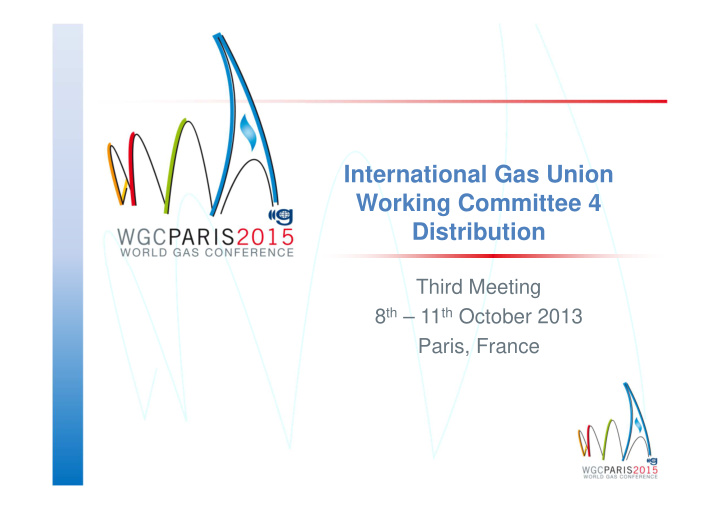



International Gas Union Working Committee 4 Distribution Third Meeting 8 th – 11 th October 2013 Paris, France
IGU WOC 4 – Reminder of Work Programme Gas distribution companies in many countries are subject to a changing economical environment. After the unbundling of the large gas companies into transport service operators and gas sales companies, the distribution companies are targeted now by the regulation authorities. In addition to that, third party access is becoming an growing issue, with the number of suppliers increasing, and not only with natural gas to enter. Biomethane and hydrogen are ecological sound entries, but to manage a stable gas quality also for sensible clients does not become easier. One solution could be smart grids and their possibilities in dispatching and quick response. Which in turn needs operating staff just as smart, and up-to-date with the fast development of electronic aides. WOC 4 Study Groups in the 2012 – 2015 Triennium 1. Regulation on Third Party Access to Gas Distribution Networks – A Standard Approach 2. Diversification of Gas Quality and Non-conventional Sources in a Carbon-free Future 3. Smart Grids in Gas Distribution
WOC 4 Study Group 1: Regulation on Third Party Access to Gas Distribution Networks – A Standard Approach � Examination of the development of regulation over the last decade in different countries – Access of gases other than natural gas – Development of marketing/charging areas – Change of energy balancing and transfer options for costs – Unbundling of distribution companies – Training and qualification of personnel – … � Preparation of an “IGU Network Code”
SG 4.1 work progress SG 4.1: Regulation of Third Party Access to Gas Distribution Networks – A Standard Approach Leader: Jose Carlos Broisler Oliver, COMGÁS, Brazil � � Vice Leader: Gabriel de Souza, Galp Energia, Portugal � Study Group Members: José Carlos B Oliver, COMGÁS, Brasil � � Gabriel de Souza, Galp Energia, Portugal Walter Piazza, GasBrasiliano, Brasil � � Rosemary Mcall, GL Group, UK Peter Demec, SPP Distribucia, Slovakia � Seong-Kyeong Hong, Kogas, South Korea � � Makoto Hiranuma, Osakagas, Japan Benoit Chaintreuil, GrDF, France � � Wijuck Krisnakri, PTT, Thailand Anna Zhur, Gazprom, Russia � Anna Dyuzheva, Gazprom, Russia � � Igor Tverskoy, Gazprom Promgaz, Russia Nick Biederman, Gas Operations Alliance, US � � Manfred Pachernegg, Gasnetz Steiermark, Austria Thiranan Kraitongsook, PTT, Thailand �
SG 4.1 work progress Final Objectives & What We Need to Do: � � Present different experiences around the world regarding TPA legislations and regulation, stage of implementation and evolution, – Benefits – Problems Identify trends of TPA around the world � Prepare a “World Map” of TPA � Prepare “IGU guidelines” of TPA – to be referenced – instead a “IGU � Network Code” Contribution to the IGU magazine, by the second semester 2014 �
SG 4.1 work progress 3 rd meeting what we did: � � SP homework evaluation � Discussion of the study cases: – US – UK – Thailand – Slovakia – South Korea � Some “work” with the raw material � Key Inputs until now � Structure of the final paper to be submitted � Key Words
SG 4.1 work progress Key Inputs until now: � � TPA is clearly associated with: – Privatization and liberalization – Vertical Integration x Unbundling – Open access – Intent to increase competition, secure supply and cost & price reduction – Requires a very rigorous & comprehensive regulatory framework – It takes time to be implemented – Not always the intended objectives are achieved – Huge variation amongst regions and countries – Different stages of implementation Examples for all above items � Future of TPA � – Inevitable?
SG 4.1 work progress Proposal for the SG Paper Structure: � Introduction: terminology, definition, subject of the study, purpose of the report, overview about TPA � models, � “TPA World Map” according to the following regions & countries (basically considering the relevance of each one in terms of volumes of gas consumption, strategic position and market maturity): – European Union (UE): France, Germany, UK, Italy, Netherland and others – Russia – North America: mainly US – South America – East Asia: Japan and South Korea – Asia Pacific: Australia, Indonesia, Malaysia, Thailand – South Asia: India, Pakistan – North Africa: Algeria, Morocco, Tunisia, Egypt – Middle East: Saudi Arabia, Oman, Qatar, Emirates – Iran, Turkey � TPA on Distribution (for each of the above regions included in the TPA World Map) – Model adopted – regulation and legislation – Objectives – explicit and implicit – What was done – Implementation timescale – Maturity level – Future tendencies – What was successful and unsuccessful x critical evaluation (quantitative and qualitative) Description about the different models � � Conclusions “IGU guidelines” of TPA �
SG 4.1 work progress Key Words: � Third Party Access � � Distribution Networks Unbundling � � Gas distribution Regulatory framework � � Open access Gas Market Liberalization � Distribution System Operator � Customer / Producer Connections � Billing in Open Grids � � Energy Balance in Open Grids Integrated Gas Markets � � Open season bidding Injection to the system �
Recommend
More recommend